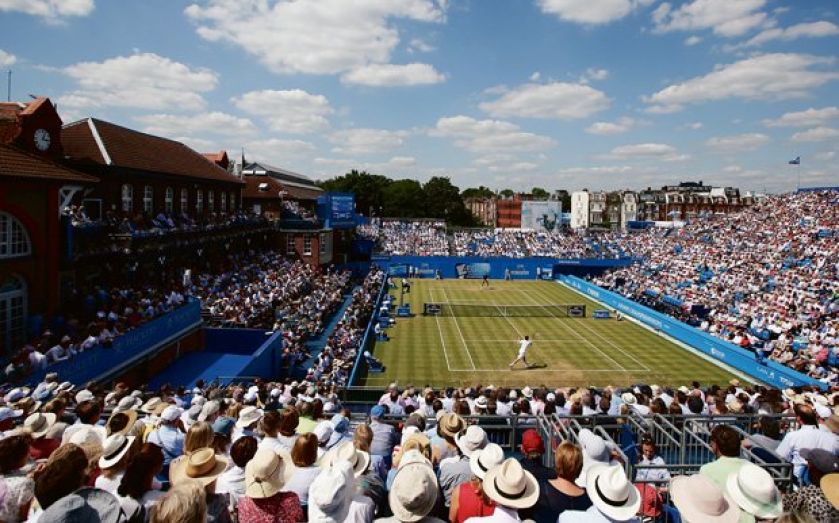Classy Queen’s Club set for landmark year… and an invasion of false onions

West London venue has never been so prominent but has retained its charm
THE SERENE surrounds of Queen’s Club are well acquainted with briefly assuming centre stage to usher in the British grass-court summer, but this time around the historic establishment is preparing itself for a prolonged and more intense spell in the spotlight.
This year the Aegon Championships, the traditional precursor to Wimbledon, has been upgraded from ATP 250 status to a 500-point ranking tournament, making it a more attractive proposition to star names and prompting a hike in prize money.
An elongated grass-court season has also allowed SW19’s marquee grand slam, and in turn the championships at Queen’s, to be shunted back a week in the tennis calendar, giving greater breathing space for players contesting the latter stages of the French Open.
The upshot is that eight of the world’s top-14 ranked players will be in residence when Queen’s opens its doors on Monday. Old friend and former world No1 Rafael Nadal has reconciled his opposition to British tax laws and returns for the first time since 2011.
In recent seasons Nadal has defected to a rival event in Halle, Germany, although history suggests his performances at the All England Club benefit from a stint at Queen’s. The 29-year-old has reached the final of Wimbledon on each of the five times he has played at the club, while Britain’s Andy Murray won both competitions two years ago.
“If you look at the names on our cup and consider a roll of honour, it’s got Boris Becker, it’s got Pete Sampras, all these great names of tennis going back to Rod Laver and John Newcombe,” Queen’s Club chief executive Andrew Stewart told City A.M.
“The one thing you want as a club is to have the right names on the cup. We know that we have got some top-ranked players this year so, by the end of it, I would think there is going to be a name on there that the cup deserves.”
But the landmark 2015 does not stop there. Queen’s Club will also play host to Great Britain’s eagerly anticipated Davis Cup by BNP Paribas quarter-final against France next month, as the nation bids to secure its first last-four slot since 1981 on the grass courts of west Kensington.
“The joy about that is that it’s something completely different. The Aegon Championships is a lovely tournament. It is very intimate and relatively restrained,” added Stewart. “The Davis Cup will be everything that that tournament is not. It will be hugely partisan. There will be people in ginger wigs and kilts and we’ll see false onions and all sorts of things around the place.”
It may be a trailblazing period for Queen’s in that regard, but the club’s 128-year history is rich in diverse feats of physical attainment and sporting alumni. Queen’s was the venue for the first Olympic gold medal to be won on British soil in 1908 by E.B. Noel in the game of rackets, and also the home of the pre-war football team known as the Corinthians, who refused to save penalties and became a byword for sportsmanship.
An international football clash between England and Wales was held onsite in 1895, while a founding member was Lord Desborough – a sporting and civic visionary who was a champion rower, cricketer, climber, fencer and swimmer. He also climbed Matterhorn and swam across Niagara Falls twice.
Post-war the club has been dominated by racket sports – lawn tennis, real tennis, rackets and squash – and its unique setting and quaint aura inevitably gives rise to the odd yarn from championships past.
“When the likes of Ivan Lendl and John McEnroe were playing here 25 years ago, these guys didn’t have cars with drivers, they used to live locally and bicycled here,” Stewart recalled.
“Ivan Lendl was quite demanding in terms of the practice courts and there was one occasion when his bicycle lost its wheels when he was due to be going back home, only for them to be found in the groundsman’s hut a little bit later.”
Nine years ago the ownership of Queen’s Club passed to the members from the Lawn Tennis Association, which it had held since 1953, following a legal wrangle that was eventually settled out of court for £35m.
Referencing membership, the club has long been synonymous with prestige and exclusivity, with a view that the dressing rooms are stocked full of celebrities and prosperous City financiers. But is that a fair representation of the modern-day Queen’s?
“In many ways the Queen’s Club Championships has gone from a smaller garden party for the rich and famous, to actually a far more tennis-orientated tournament,” added Stewart.
“British tennis members and the general public feel that it is far more their tournament now than it used to be. Queen’s has this reputation of being full of well-heeled members, but actually it has become far more egalitarian.
“It’s just like any other tennis club, just one that is in an incredibly good position, at the end of Barons Court. When you look around it’s hard to believe there is this oasis in the middle of suburbia.”